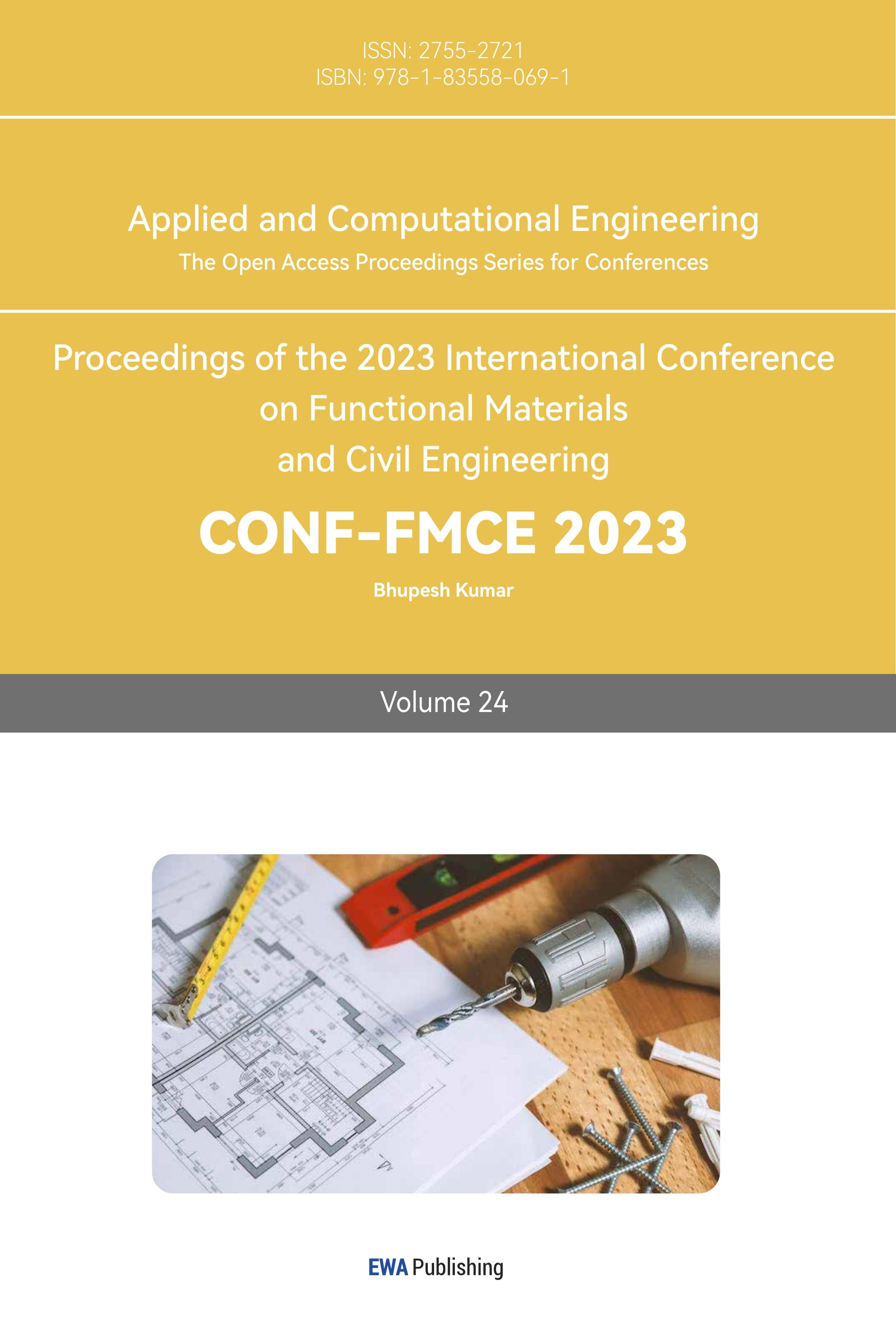1. Introduction
With the development of modern engineering technology, the scale of construction projects is getting larger and larger, and the structure is getting more and more complex, so that the traditional engineering technology is gradually unable to complete. In conventional construction methods, designers often create 2-dimensional drawings by using typical engineering software [1]. As shown in figure 1, according to researches on the use of computer aided design (CAD), most civil engineers in engineering fields only use CAD to create two-dimensional drawings instead of learning how to draw three-dimensional drawings [2]. No matter in the architecture, or in the engineering and construction industry, novel data analytics strategies for digital transformation are needed [3-5]. Through data fusion, information can be integrated more consistently and accurately [6].
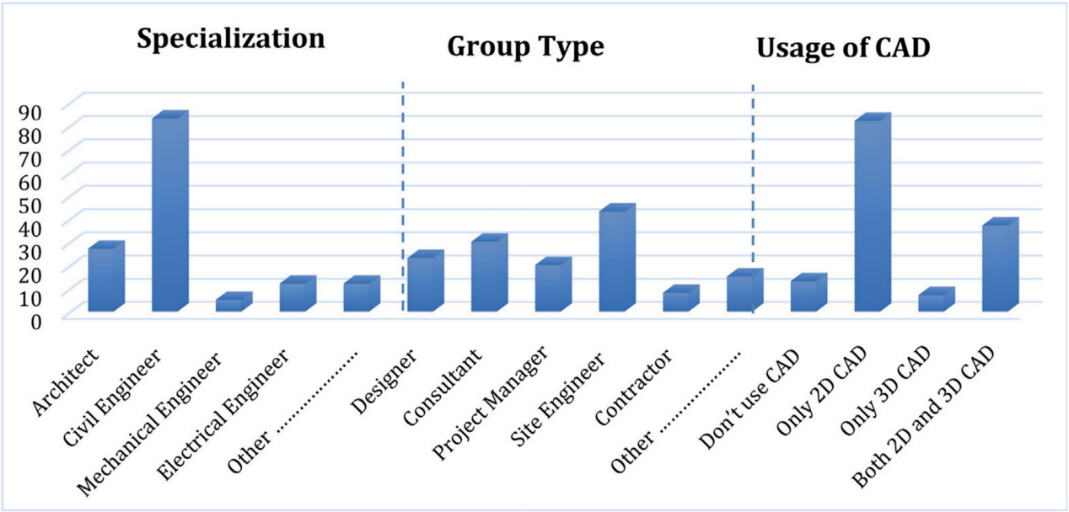
Figure 1. Specialization, job type and CAD using [2].
Building information modeling (BIM) can successfully control the whole procedure in engineering with the ability to base on 3-dimensional technology, integrate all the construction information, and indicate the main structure and functional feature of the building by digital technology. The outstanding characteristics of BIM including visualization, coherence, simulation and the possibility of optimization. Designers and workers can use BIM to create virtual models, which make it possible to share information simultaneously. With the diagrams created by BIM, it is more convenient for designers to modify and optimize [7]. Through applying BIM technology to engineering projects, the productivity efficiency can be improved. Meanwhile, the engineering quality and the operating safety can also be improved. BIM, used in the design, construction and management periods, can attain the visible technologies and achievements in engineering projects. In this paper, the advantages of BIM application, the existing risks and countermeasures are mainly analyzed in detail.
2. Characteristics and advantages of BIM
2.1. Characteristics of BIM
2.1.1. Visualization. BIM has the ability to transfer 2-dimensional diagrams into 3-dimensional diagrams, which are definitely much more intuitive [8]. Through 3-dimensional diagrams, the thoughts of designers can be clearly expressed, which can identify the omissions in construction details. Meanwhile, BIM is able to help workers better understand the key points and difficult points in the project. With the help of 3-dimensional models, workers can connect with each other more easily.
2.1.2. Simulation. BIM models provide large amounts of data information, including geometric information, management information, technology information and so on. By analyzing that information, all procedures such as manufacture management, costs control, construction program selection can be simulated [8]. Since the conditions are simulated in advance and the details are clear, and the time scale of the project can be shortened, BIM technology can greatly simplify the entire construction process. In addition, BIM can also be used to simulate emergencies like earthquakes and fire. In that case, solutions towards those emergencies can be prepared in advance.
2.1.3. Optimization. The application of BIM can be better and more efficient in design and construction. In traditional engineering, lacking of information can cause failure in project optimizing. In contrary, BIM has the ability to optimize due to the information containing in its models. With the ability to improve the problem orientation of construction management, BIM can make workers prepare targeted solutions. Therefore, BIM technology can reduce the possibility of problem occurrence, and improve the total quality in engineering projects. When doing complex projects, BIM is able to optimize the accuracy in diagrams.
2.2. Advantages of BIM application
As a brand-new construction method, BIM can be applied to the whole procedure in engineering projects. Monitoring efficiency can be greatly improved after using BIM to monitor structure safety [9]. Different from software used in typical engineering design, BIM create 3-dimensional models instead of 2-dimensional diagrams. When designing the structure, designers are able to virtualize the models and express them by digital diagrams. The 3-dimensional models can help workers search the required equipment quickly, which can effectively reduce workers’ workload. In typical engineering drawing technology, strong specialized technology and extensive working experience are needed to discover the defects in engineering projects. BIM information technology can easily discover the unreasonable points using 3-dimensional models [9]. For instance, BIM technology can do 3-dimensional simulation on elements that are about to installed. In this way, errors in the building can be checked out intuitively [9]. In costs calculating, BIM information technology can help engineers handle more information accurately and properly, which make it possible for them to complete lots of work in short time. Also, BIM information technology can provide a co-working platform for each department in the project to exchange information. Thus, all information including design, construction and management can be shared spontaneously. BIM technology can help reinforcing the effective utilization of management sources, making sure not only inducing the costs and working intensity, but also satisfy multifaceted needs in construction. In other words, BIM can bring many benefits to engineering projects by providing information and digital management, and take advantage of it.
3. Application of BIM technology in engineering projects
3.1. Application of BIM technology in engineering designing
Nowadays, modern building is quite different from traditional ones, which often have much more complex designs. In that case, normal 2-dimensional diagrams apparently unable to express the whole structure. Thus, 3-dimensional models created by BIM technology can intuitively express the structure and key points in elements, making constructors better understand the important information in architectural structures [10]. Using collision detection in BIM technology, engineering projects can be simulated and optimized. Unreasonable points can be correctly identified as well. BIM can help constructors get familiar with the building rapidly and reduce the accidental risks in construction process. Therefore, the construction safety can be protected, especially in skyscraper construction.
BIM technology can save both time and cost in real engineering project design. In a traditional engineering process, workers should construct based on the drawing the designer created, and discussion is needed when problems encounter in order to modify the design. Only then, construction and other essential process can be followed. Apparently, the whole process requires several years to be done, which is time-consuming. After turning to BIM technology to build 3-dimensional models rather than typical 2-dimensional ones, it only takes about a month to create the model of the entire structure. Meanwhile, by using collision detection, more than 90% of rework together with material waste can be avoided [11]. In that case, time and cost can all be greatly reduced. Figure 2 can be used to evaluate before and after the project is optimized by BIM technology.
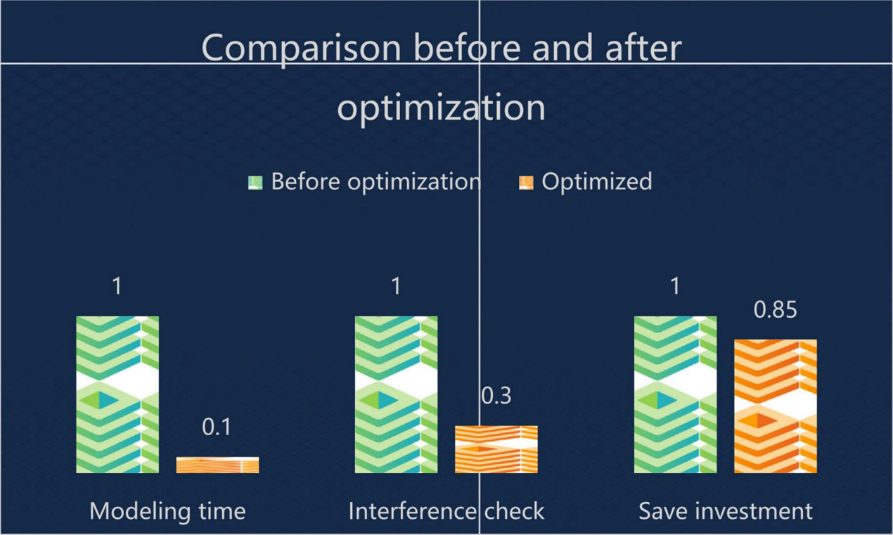
Figure. 2 Comparison of before and after optimization using BIM technology [11].
3.2. Application of BIM technology in engineering construction
In most large construction projects, the entire construction cycle is long, and each job is different in content and emphasis. Therefore, collaboration between departments is very important. Otherwise, there may be a series of errors in the construction process, which will have a great impact on the quality of construction. Through BIM technology, the construction process can be standardized, while the total process can be designed more reasonable. That is, most errors can be avoided. For instance, in the construction of steel reinforced concrete structure, the construction order can be optimized by adding BIM analysis into construction evaluation. Meanwhile, as the workers able to master the key points in reinforced concrete structure, BIM modeling can improve the construction efficiency [10]. Those are the major advantages in BIM technology application.
Since most of the old roads designed decades ago still exist and easily fail to meet the requirements of modern traffic, road widening is often used as a solution to the problem. During the construction process, building demolition can always be an essential but difficult part. The process can be done accurately through using BIM technology. By creating as-is BIM models, engineers can make decisions with the help of models of related projects together with surroundings and the environment. Figure 3 shows the overall workflow of the process. Among the steps, data of topography, Digital Terrain Model (DTM), and Digital Surface Model (DSM) can be obtained from resources such as Google Earth [12].
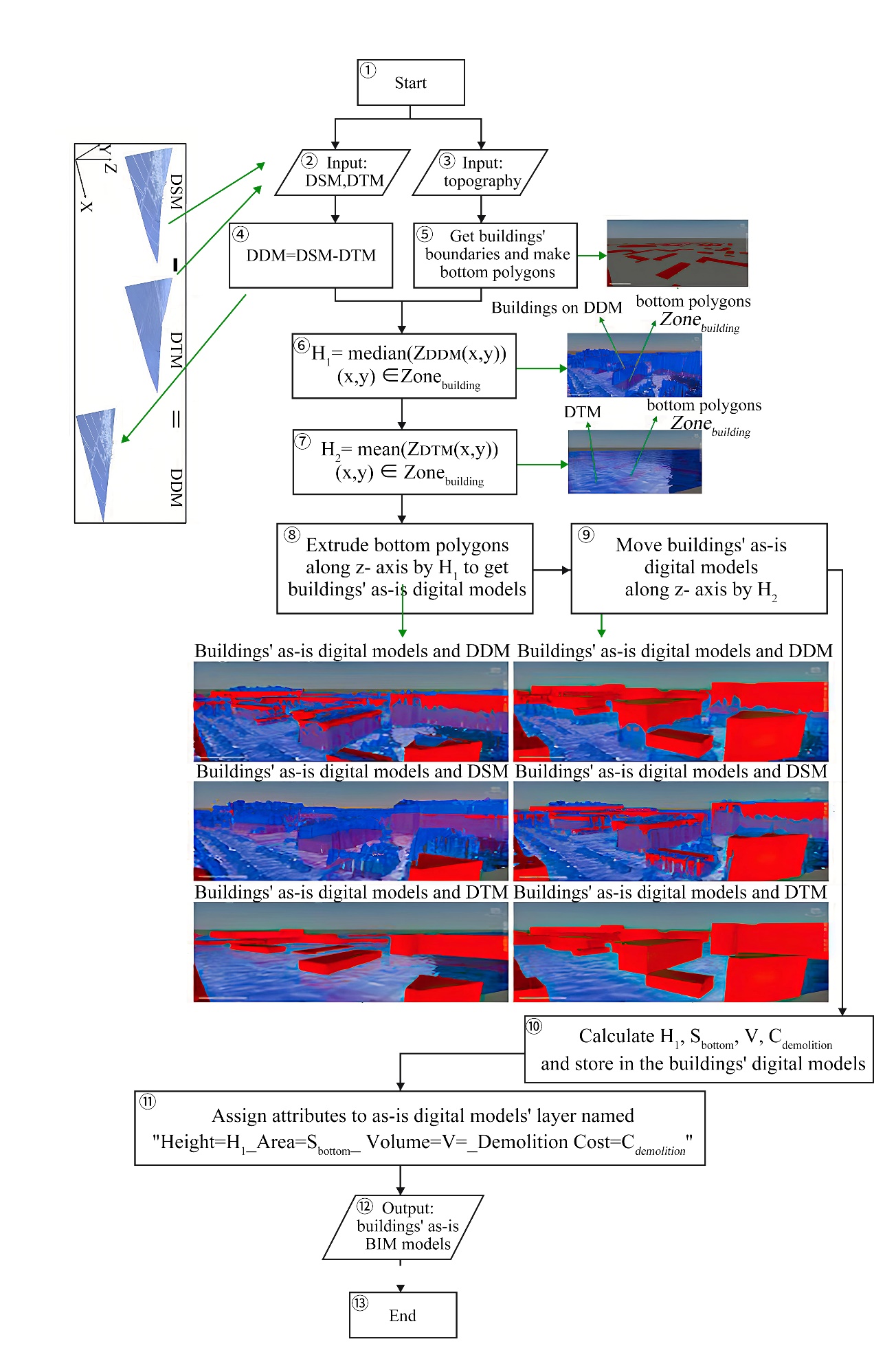
Figure 3. Workflow for buildings' as-is BIM models creation [12].
3.3. Application of BIM technology in engineering management
No success engineering project can be accomplished without a well-established engineering management. There is no doubt that typical management pattern has lots of deficiencies. First, it’s mostly based on manpower, which obviously lacks efficiency. Also, the management quality is not up to standard as well. Therefore, the main system of current engineering projects is to use information technology, which is called information management. As an important part of information management, BIM technology can help solve many management problems. BIM technology can be used to accomplish the information management system and standardize the building construction process. For instance, people management, material management, machine management, quality management and integrated management can all be added into BIM technology management system [10]. In that case, the whole procedure of construction is controlled scientifically.
Analytic Network Process (ANP) can be used to show the relationships in an engineering project. Using figure 4, the ANP network depicts the relationships clearly. One-way arrows and two-way arrows both are used to indicate the interactions between different perspectives [13]. For instance, if ‘Timely BIM delivery’ changes, ‘Customer satisfaction’ will change as well.
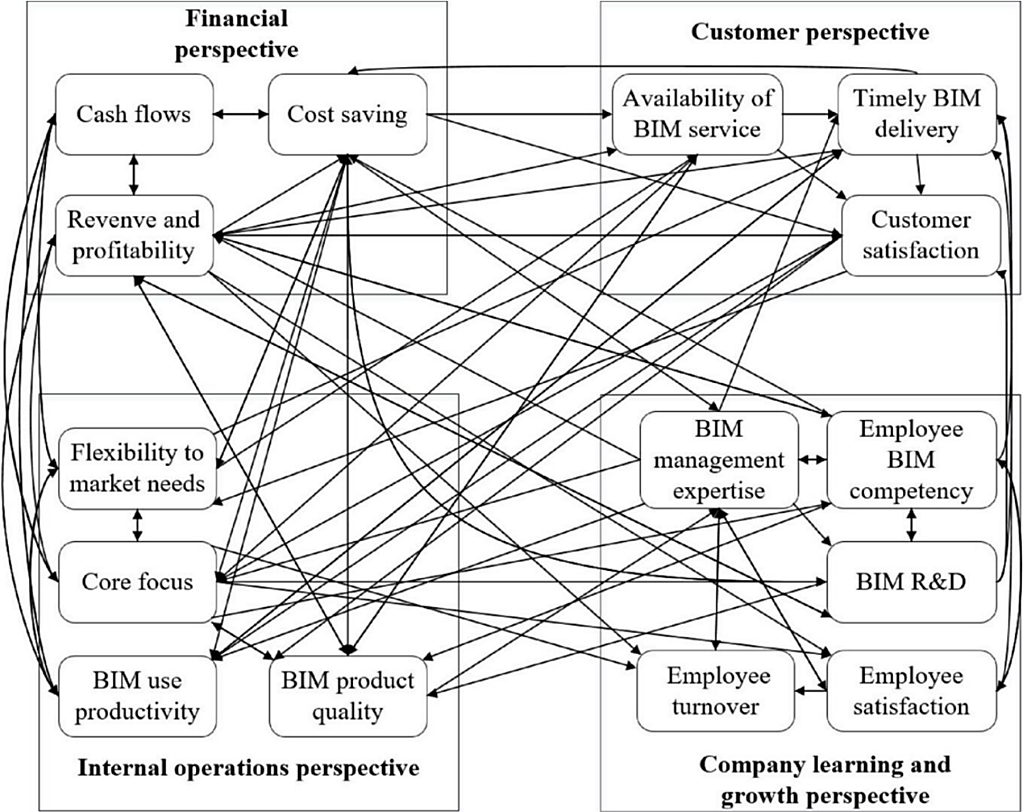
Figure 4. ANP network [13].
4. Risks and countermeasures of BIM technology
With the rapid development of BIM technology, it is now applied to various situations. While the application of BIM is placed a much higher value, some risks in BIM promotion can also not be ignored.
4.1. Risks of BIM construction projects
4.1.1. Inputs and outputs. As a modern technology, BIM lacks skilled technicians. At the same time, BIM technology is so complex that professional technicians are needed to make full use of it. Since most designers are used to create 2-dimensional diagrams in engineering projects, they are unwilling to master a totally different technology [10]. In addition, BIM usage should be accompanied with related equipment. In that case, engineers unable to study it self-finance. Also, the development of BIM technology costs much. Thus, the promotion of BIM technology requires large amounts of funding, including the purchase of related software and hardware equipment, the training fees of BIM related specialists, and the funding of other infrastructures. Meanwhile, BIM technology cannot earn much in short time, which is the main reason why many companies lack passion to develop and promote BIM.
4.1.2. Standard Unification. Another risk is that the standards in different platforms are usually not uniformed. BIM construction design involving integration and design using various engineering information. In different periods of engineering projects, data formats and file structures vary. When the data transfers to different software, standards may become incompatible easily. In that case, important data may lose, and the efficient co-working of information between different fields can’t be accomplished [8]. Meanwhile, technology in different fields is needed to be coordinated, thus requires advanced technology in each subject. In most cases, projects do not achieve the best in every discipline, so the advantages of BIM technology cannot be fully exploited.
4.2. Countermeasures towards the risks in BIM usage
Firstly, enterprises should pay more attention to the output of BIM technology in various disciplines. BIM has the ability to complete the whole process of engineering projects and realize multi-dimensional interaction between various subjects [14]. Considering the possibility of optimize the costs in every phase of project, the efficiency can be greatly improved. Companies are required to enhance their understanding towards BIM technology and invest more on technicians’ training. As for standard unification, much more scientific platform should be established. Improving the capacity of BIM technology in implementation is also good for the promotion of BIM technology. In addition, companies can gradually equip various software and hardware. At the same time, invests should be used to develop a more all-in-one software.
5. Conclusion
BIM technology has become one of the advanced technologies in modern engineering. By applying BIM technology to engineering design and construction, the visualization and consistency of engineering safety can be greatly improved, and the construction risk is effectively predicted. For the problems existing in the promotion process of BIM technology, a more complex system needs to be established. It is necessary to focus on the long-term benefits of investing in BIM technology, and to train professional and technical personnel who specialize in using BIM technology.
With the development of modern technology, especially the innovation of information technology, BIM can be applied to many other fields. Future technologies must be used in conjunction with several related disciplines. In the construction industry, both the Internet of Things and the information network should be diversified. At the same time, BIM technology should be simplified to improve its humanization and facilitate the use of architects.
6. References
[1] Maglad A, Houda M and Alrowais R 2023 Bim-based energy analysis and optimization using insight 360 (case study) Case Studies in Cconst. Materials 18 e01755
[2] Yousif Y, Sarhat M and Farsat H 2023 Investigating BIM level in Iraqi construction industry Ain Shams Eng. J. 14 101881
[3] Boje C, Guerriero A, Kubicki S and Rezgui Y 2020 Towards a semantic Construction Digital Twin: Directions for future research Autom. Constr. 114 103179
[4] Ozturk G 2021Digital twin research in the AECO-FM industry J. Build. Eng. 40 102730
[5] LuVivi Q, Kumar P, WoodallPhilip R and HeatonJames D 2019 Developing a dynamic digital twin at a building level: using cambridge campus as case study Int. Conf. on Smart Infrastructure and Construction (ICSIC) pp 67-75
[6] Castanedo F 2013 A review of data fusion techniques Sci. World J. 2013 704504
[7] Chen Y 2023 Research on application of BIM technology in computer aided building design Concrete World 164 pp 35-38
[8] Wang B and Xiao X 2023 Research on the application of BIM technology in construction projects, Sci.Tech. Innova. 05 164-169
[9] Liu H 2023 Discussion on the application of BIM in construction engineering Tech. Discuss. pp 53-55
[10] Lu C 2023 Application and promotion strategy of BIM technology in architectural design Architectural Design pp 56-58
[11] Chen Y 2022 Design and optimization of construction equipment pipelines in cigarette factories based on BIM technology Ain Shams Eng. J. 102054.
[12] Jiang F, Ma L, Broyd T, Chen K, Luo H and Du M Building demolition estimation in urban road widening projects using as-is BIM models Automation in Construction 144 (2022) 104601
[13] Chen G, Yan Z, Chen J and Li Q 2022 Building information modeling (BIM) outsourcing decisions of contractors in the construction industry: Constructing and validating a conceptual model Developments in the Built Environment 12 100090
[14] Chen J and Cui P 2023 Application of BIM technology in construction management of building projects Vocational Education and Technology Applications 245(04) pp 151-153
References
[1]. Maglad A, Houda M and Alrowais R 2023 Bim-based energy analysis and optimization using insight 360 (case study) Case Studies in Cconst. Materials 18 e01755
[2]. Yousif Y, Sarhat M and Farsat H 2023 Investigating BIM level in Iraqi construction industry Ain Shams Eng. J. 14 101881
[3]. Boje C, Guerriero A, Kubicki S and Rezgui Y 2020 Towards a semantic Construction Digital Twin: Directions for future research Autom. Constr. 114 103179
[4]. Ozturk G 2021Digital twin research in the AECO-FM industry J. Build. Eng. 40 102730
[5]. LuVivi Q, Kumar P, WoodallPhilip R and HeatonJames D 2019 Developing a dynamic digital twin at a building level: using cambridge campus as case study Int. Conf. on Smart Infrastructure and Construction (ICSIC) pp 67-75
[6]. Castanedo F 2013 A review of data fusion techniques Sci. World J. 2013 704504
[7]. Chen Y 2023 Research on application of BIM technology in computer aided building design Concrete World 164 pp 35-38
[8]. Wang B and Xiao X 2023 Research on the application of BIM technology in construction projects, Sci.Tech. Innova. 05 164-169
[9]. Liu H 2023 Discussion on the application of BIM in construction engineering Tech. Discuss. pp 53-55
[10]. Lu C 2023 Application and promotion strategy of BIM technology in architectural design Architectural Design pp 56-58
[11]. Chen Y 2022 Design and optimization of construction equipment pipelines in cigarette factories based on BIM technology Ain Shams Eng. J. 102054.
[12]. Jiang F, Ma L, Broyd T, Chen K, Luo H and Du M Building demolition estimation in urban road widening projects using as-is BIM models Automation in Construction 144 (2022) 104601
[13]. Chen G, Yan Z, Chen J and Li Q 2022 Building information modeling (BIM) outsourcing decisions of contractors in the construction industry: Constructing and validating a conceptual model Developments in the Built Environment 12 100090
[14]. Chen J and Cui P 2023 Application of BIM technology in construction management of building projects Vocational Education and Technology Applications 245(04) pp 151-153
Cite this article
Chen,Y. (2023). Application analysis and evaluation of BIM in engineering design and construction stages. Applied and Computational Engineering,24,43-50.
Data availability
The datasets used and/or analyzed during the current study will be available from the authors upon reasonable request.
Disclaimer/Publisher's Note
The statements, opinions and data contained in all publications are solely those of the individual author(s) and contributor(s) and not of EWA Publishing and/or the editor(s). EWA Publishing and/or the editor(s) disclaim responsibility for any injury to people or property resulting from any ideas, methods, instructions or products referred to in the content.
About volume
Volume title: Proceedings of the 2023 International Conference on Functional Materials and Civil Engineering
© 2024 by the author(s). Licensee EWA Publishing, Oxford, UK. This article is an open access article distributed under the terms and
conditions of the Creative Commons Attribution (CC BY) license. Authors who
publish this series agree to the following terms:
1. Authors retain copyright and grant the series right of first publication with the work simultaneously licensed under a Creative Commons
Attribution License that allows others to share the work with an acknowledgment of the work's authorship and initial publication in this
series.
2. Authors are able to enter into separate, additional contractual arrangements for the non-exclusive distribution of the series's published
version of the work (e.g., post it to an institutional repository or publish it in a book), with an acknowledgment of its initial
publication in this series.
3. Authors are permitted and encouraged to post their work online (e.g., in institutional repositories or on their website) prior to and
during the submission process, as it can lead to productive exchanges, as well as earlier and greater citation of published work (See
Open access policy for details).
References
[1]. Maglad A, Houda M and Alrowais R 2023 Bim-based energy analysis and optimization using insight 360 (case study) Case Studies in Cconst. Materials 18 e01755
[2]. Yousif Y, Sarhat M and Farsat H 2023 Investigating BIM level in Iraqi construction industry Ain Shams Eng. J. 14 101881
[3]. Boje C, Guerriero A, Kubicki S and Rezgui Y 2020 Towards a semantic Construction Digital Twin: Directions for future research Autom. Constr. 114 103179
[4]. Ozturk G 2021Digital twin research in the AECO-FM industry J. Build. Eng. 40 102730
[5]. LuVivi Q, Kumar P, WoodallPhilip R and HeatonJames D 2019 Developing a dynamic digital twin at a building level: using cambridge campus as case study Int. Conf. on Smart Infrastructure and Construction (ICSIC) pp 67-75
[6]. Castanedo F 2013 A review of data fusion techniques Sci. World J. 2013 704504
[7]. Chen Y 2023 Research on application of BIM technology in computer aided building design Concrete World 164 pp 35-38
[8]. Wang B and Xiao X 2023 Research on the application of BIM technology in construction projects, Sci.Tech. Innova. 05 164-169
[9]. Liu H 2023 Discussion on the application of BIM in construction engineering Tech. Discuss. pp 53-55
[10]. Lu C 2023 Application and promotion strategy of BIM technology in architectural design Architectural Design pp 56-58
[11]. Chen Y 2022 Design and optimization of construction equipment pipelines in cigarette factories based on BIM technology Ain Shams Eng. J. 102054.
[12]. Jiang F, Ma L, Broyd T, Chen K, Luo H and Du M Building demolition estimation in urban road widening projects using as-is BIM models Automation in Construction 144 (2022) 104601
[13]. Chen G, Yan Z, Chen J and Li Q 2022 Building information modeling (BIM) outsourcing decisions of contractors in the construction industry: Constructing and validating a conceptual model Developments in the Built Environment 12 100090
[14]. Chen J and Cui P 2023 Application of BIM technology in construction management of building projects Vocational Education and Technology Applications 245(04) pp 151-153





